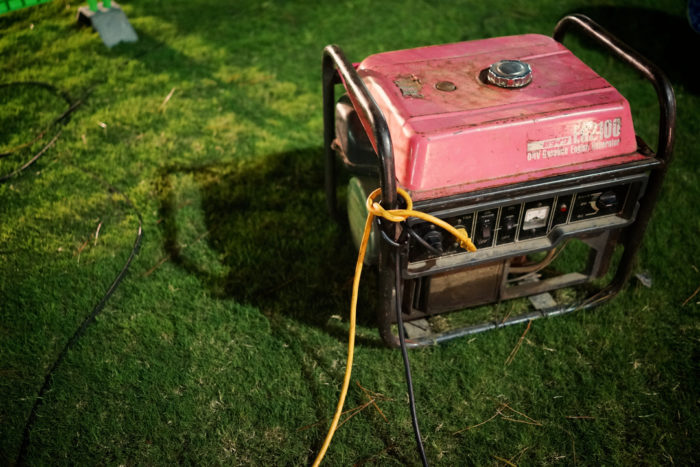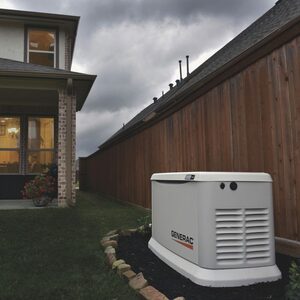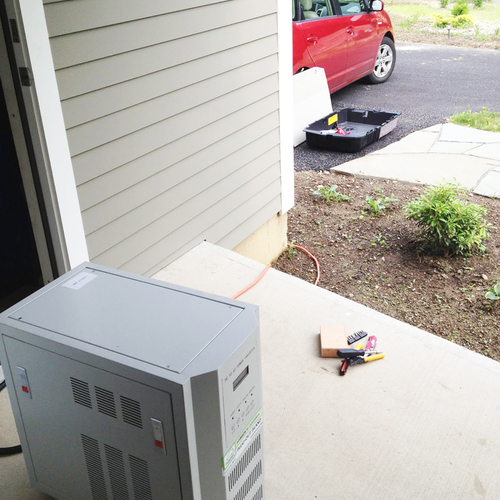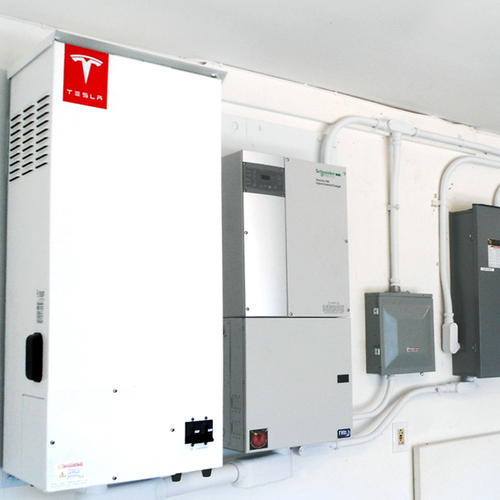
Image Credit: Tablesxxnx via Flickr
Writing from central Kentucky, Clay Whitenack poses this question: in an all-electric house, what’s the best way of providing power when the grid is down?
Whitenack and his family live in a new house, a house that does not have a fireplace or a wood stove. “This leaves us vulnerable in the event of a power outage during a bad winter,” he writes in a post at the Q&A forum. “We live in central Kentucky, so the winters here are usually not too bad, but we do have times when the temps get below freezing for extended periods of time.”
The house is well-insulated and heated with ductless minisplits; domestic hot water is produced by a heat-pump water heater. Whitenack’s first thought about emergency backup power is a solar array.
“I would like to start researching a small solar array that would allow me to keep the essentials going,” he says. “Things like heat, hot water, the fridge, stove, and maybe a few outlets around the house for a few lights, charging mobile devices, etc.”
He wonders how to calculate the amount of electricity he’d need in a pinch, and what the capacity of a photovoltaic system might be. At least that’s where this Q&A Spotlight begins.
How long is an outage really going to last?
A well-insulated house in Kentucky isn’t likely to have plumbing freeze-ups even in very cold weather, says Dana Dorsett, so a small woodstove might be enough to keep everyone comfortable during a power outage, and it would not require “punching huge holes in your efficient building envelope.”
More to the point, Kentucky has a reliable electric grid and power outages that extend beyond a day or two are “extremely rare,” Dorsett says, adding, “The capital…
Weekly Newsletter
Get building science and energy efficiency advice, plus special offers, in your inbox.

This article is only available to GBA Prime Members
Sign up for a free trial and get instant access to this article as well as GBA’s complete library of premium articles and construction details.
Start Free TrialAlready a member? Log in















12 Comments
Ice Storms
Clay’s concerns are not unfounded in this part of the world we have ice storms they happen every 10 years or so.
https://en.wikipedia.org/wiki/Ice_storm
What happens is we have a long cold snap followed by a cold rain. The rain freezes on contact with any surface when it is bad the ice can be 3 inches thick. The weight of the ice will take down trees, wires and utility poles. The roads will be impassable half the electric grid has been known to go down. Yes repair crews will come from all the joining states and they will repair in an order where each repair will restore power to the most homes. If you are unlucky and the wire from your home to the pole fails you may not get to the top of the list for 10 days.
Clay’s real question is how I can keep my family and pipes from freezing if I am without electric for 10 days?
A small portable generator will run your freezer refrigerator and light but without heat you will be miserable.
How can he run his mini split?
Yes I have personally been unlucky enough to have to have 3 separate multi day power outages in less than 2 years. But most of the blame goes to the regulators that let the utility stop tree trimming for years to save money and bump up profits at the expense of reliability.
Walta
For thermal backup...
... wood stove. Or even COAL stove.
An ice storm left me without power for 10 days in December 2008, with overnight lows dipping to +10F, in a well below-code-min house. Camping out there wasn't an option, but it was possible to intermittently run the gas-fired kitchen range and fill the bathtubs with the dumb lo-tech water heater we had at the time to keep the pipes from freezing over night.
That experience was an incentive to install a wood stove for auxilliary heat (which I don't regret at all...) in the pre-existing miserable leaky backdrafting open hearth fireplace. Had the wood stove been in place at the time we would have continued to stay there as grid repairs were in progress all around us.
Running the mini split
Walta I have the same question if you wanted to prioritize a mini split power supply for emergencies is it possible to use a battery backup like a powerwall to power a 2 ton unit. I guess the question comes down to how much ampage does the unit draw on start up and would something like a powerwall be able to kick in quick enough to stop the unit from shutting down if it’s already running which should help keep the amp draw lower. I tried looking at the submittal sheets but I can only find breaker size for the amps not what they use on cold starts so no idea how to calculate how long a battery could keep them going if that was the only thing on them.
Response to Chris King
Chris,
The most dependable way to keep your minisplit going when the power goes out -- and the least expensive way -- is to buy a generator.
While it's common to worry that a power outage will make it impossible to run a minisplit heat pump, readers should remember that a power outage will also make it impossible to run a furnace or boiler. All central heating systems are disabled by a power outage. If you want heat during a power outage, take Dana Dorsett's advice and get a wood stove -- or install a propane space heater with through-the-wall venting.
Thanks Martin
Yes a portable generator is easily the easier and more economical approach I am more just curious if a fully charged powerwall could do it then the practicality behind it. Also in regards to the wood stoves being the only sure fire way way to get heat with no power. Give it a few years I’m sure someone will come out with a wood stove with electronic monitoring to help optimize burning. Then when the power goes out it locks the stove door since it isn’t optimized. Put electronics in everything that’s the way we’re heading....just saw a commercial for a mattress with a sensor mesh in it to monitor sleep.....
Good advice
"A warm wood stove evokes fond memories for many Americans. But a wood stove doesn’t belong in a green home. It’s just too hard to balance a wood stove’s voracious appetite for combustion air with a modern home’s need to limit air leakage."
Read more: https://www.greenbuildingadvisor.com/articles/dept/musings/things-you-do-not-need#ixzz57ek6LBaG
Response to Chris King
Chris my point is if your home is all electric you are vulnerable to extended power outages.
It makes me feel better to have some stored energy on site. At this point I am not ready to drink "battery wall" kool aide.
If you do I would say size your battery for the worst case and be able to power the factory recommended circuit breaker.
If you plan on running a heat pump with a generator it is very unlikely to be a “portable generator”
In my last home we could operate the gas furnace on the portable generator. In my new home the back up to the heat pump is a propane fireplace.
Walta
Better Buildings by Design presentations are available!
I wanted to let you know that presentations are available online. Go to: https://contractors.efficiencyvermont.com/bbd/schedule.
Click on the button that says "View the Interactive Conference Schedule"
After each session description, there is a header that says “Presentation(s):” and then a button to download the talk. Thanks!
Heat
Clay initially indicates his biggest concern is heat, then the discussion moves into how to provide enough electricity to do that and run other things - which proves to be a big ask. If you remove heat from the problem, everything becomes a lot easier.
I'd install a propane space heater as back-up. With that, a Honda 2000 portable generator would run enough lights, refrigeration, TVs and computers, and a couple of induction hobs to cook on - all pretty inexpensively.
Backup Power
Clay's question was "what's the best way of providing power when the grid is down"?
The best (i.e. easiest and least costly) way - without question - is a wood stove and some sort of (Honda) 2 or 3 KW gas generator. Whenever the generator is needed, run an extension cord into the house from the generator. EDIT: Malcolm's idea of a propane space heater is a good idea, as long as it doesn't need electricity for a fan.
Solar is complicated and expensive. Lots of decisions and calculations, and lots of money. Not something I would consider for a backup solution. Sure, you can throw in a 300W panel and connect a few 12v lights, but what do you do as soon as the sun goes down (which is when you need the lights, lol) or if it's cloudy for a week?
Battery backup (with or without solar) depends on how long you want to survive. It's expensive, and there are a number of storage and maintenance issues. If you want to provide backup for a few hours or maybe one day of essentials that's one thing. But anyone who thinks they want battery backup for a modern house for 2 weeks may as well take out another mortgage.
Let's say you go Walmart cheap and buy 8 deep cycle Walmart batteries and setup a 12v or 24v system with an inverter. You'll get let's say 800 AHr of reserve from those batteries in series. Don't forget good super heavy gauge cables and a short run only. Now you're $1,200-$1,500. On a 12v system this will give you about 10 kwh of power if you drain the batteries until they're dead (not a good idea). In a fully modern house, even a green conscious household, you might get a day, probably half a day on this. Maybe throw in 2 or 3 300W solar panels (depends on your available sun, etc.) and a charge controller to try to charge the batteries when you get a partial day of sun during the three days the grid is down. Don't forget the mounting brackets, wires, maybe a home made mounting pole if it's not going on your roof, etc. I'd say you're at least an additional $2,500. And this is Jeb's backyard version with batteries that probably won't last 10 years even if you keep them topped up, don't drain them repeatedly until their dead, and don't put them through a lot of cycles.
Like I said, go buy a Honda 2KW full inverter generator and a heavy gauge extension cord or two. Better yet, buy 2 of those Honda generators and connect them in series (easy). Best solution by far.
Solar + wood stove
My house had solar panels with batteries and a wood stove before I connected to the grid so I never did the calculations to determine the cheapest way to get heat and backup power. But I do appreciate that when the power goes off I might not even notice if I did not get a text message from the power company. And of course the batteries are silent while the generator is noisy. If you are doing solar panels and a wood stove anyway, consider adding some batteries can give you power for a day or so. If you live where outages are sometimes longer than that, then also get a generator to recharge the batteries.
I'm full off-grid, with 36 330 watt panels, 30kwh of lithium Iron Phosphate batteries, and a backup 14kw propane generator.
When the sun comes up every day or every other day or so, I'm fine. But we just went through 3 weeks of snow/clouds, etc. and I burned through 10 gal of propane a day, just to keep the lights on, and I heated with a wood stove in the basement.
Solar and batteries are our first line, and as backup an auto-start propane generator to charge the batteries when the batteries get to 20% SOC.
We like to use the wood stove, just to help conserve on propane - otherwise we use a propane fired instant-on radiant heat system.
Log in or become a member to post a comment.
Sign up Log in